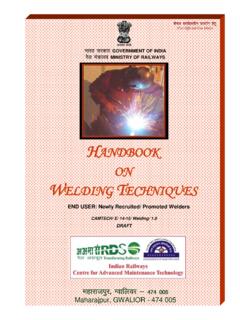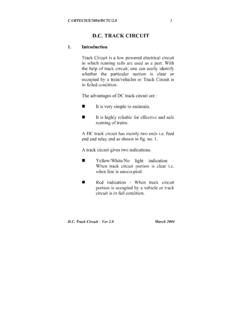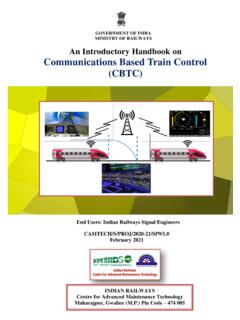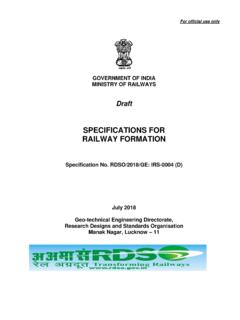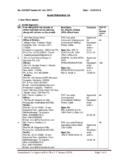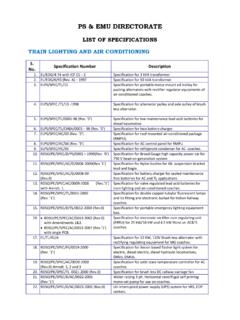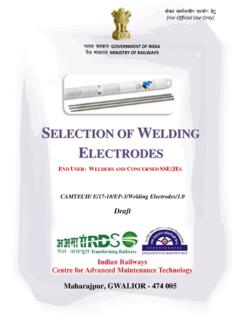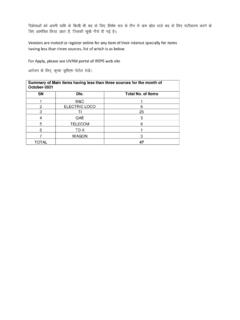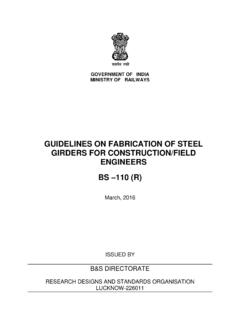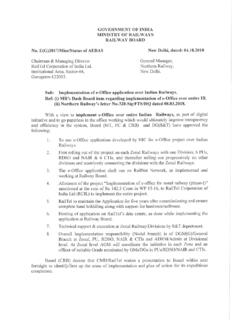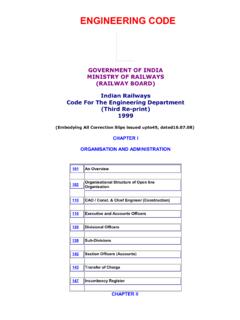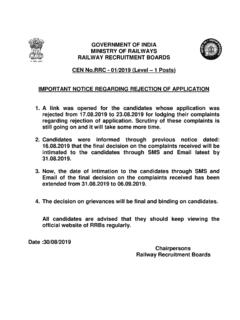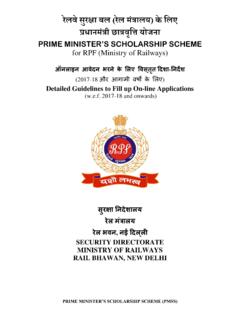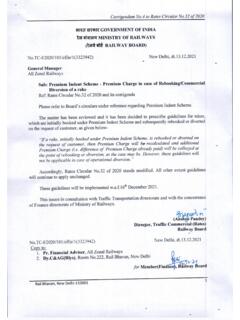Transcription of Government of India - Ministry of Railways LEVEL CROSSING
1 3333333333333332 Government of India - Ministry of Railways LEVEL CROSSING CAMTECH/2009/C/L- March 2009 Centre for Advanced Maintenance TECH nology Maharajpur, Gwalior - 474 005 Excellence in Maintenance (For official use only) LEVEL CROSSING Foreword India is a thickly populated country with increasing demand for transportation, both rail and road traffic is continuously increasing. This has necessitated construction of very large number of LEVEL crossings on railway track. Due to astronomical number of LEVEL crossings in our country, it has not been possible to man each and every LEVEL CROSSING .
2 Therefore, we have both manned as well as unmanned LEVEL crossings. To ensure safety of road as well as rail passengers, it is utmost important to maintain LEVEL crossings impeccably. It is in this direction that handbook on LEVEL crossings has been prepared by CAMTECH. The book incorporates all important aspects of LEVEL CROSSING maintenance and operation including list of equipments, requirements of indicator etc. The book also incorporates useful drawings for important items such as speed breakers, indicators etc. With these extremely useful topics, I am sure this handbook will prove to be extremely useful to the field staff at all levels and will serve as a reference to the operating and maintenance staff.
3 We welcome any suggestions from our readers for further improvement. CAMTECH/Gwalior Date : Executive Director Preface Indian Railways is experiencing a period of continuous growth both in freight and passenger traffic. This increasing demand is being met by more intensive utilization of the railway assets. Railway men often get baffled when an accident occur on a reasonably well maintained track & vehicle. LEVEL CROSSING is the location, where most of the accident attributed to road users. Even then Railways suffers badly. The handbook on LEVEL CROSSING is expected to fully meet the requirement of Railway men working on Indian Railway on the construction, maintenance and operation fields.
4 In addition to providing the necessary technical details about the LEVEL CROSSING , the theory behind its development has also been presented in a simple way to use for the civil engineering personnel. This handbook is aimed at assisting the field maintenance staff. It is and should be used only as a compliment in the daily routine to enhance the safety on LEVEL CROSSING . This handbook is prepared with the objective to provide informative technical details on ' LEVEL CROSSING ' for the guidance of civil engineering personnel involved in operating and maintenance. This handbook does not supersede any existing instructions from Railway Board, RDSO & Zonal Railways and the provisions of IRPWM, BIS codes & reports on the subject.
5 This handbook is not statutory and contents are only for the purpose of guidance. Most of the data & information mentioned herein are available in some form or the other in various books and other printed matter. We welcome any suggestions from our readers for further improvement. CAMTECH/Gwalior Sushil Kumar Date : Director/Civil CONTENTS Sr. No. Topic Page Nos. Foreword i Preface ii Contents iii Correction slip iv Classification of LEVEL CROSSING 1 Gates & Locking arrangements 1 Skew LEVEL CROSSING 2 Gate lamp and blinders 2 Traffic and Engineering gates 2 Equipments at LEVEL CROSSING 2 Maintenance & Inspection of LEVEL CROSSING 4 Visibility requirements for un-manned LEVEL CROSSING 5 Census of traffic at LEVEL CROSSING 5 LEVEL CROSSING indicators 6 Speed Breakers 7 Protection of LEVEL CROSSING 10 Common problems at LEVEL CROSSING 11 Notes ** ISSUE OF CORRECTION SLIPS The correction slips to be issued in future for this handbook will be numbered as follows.
6 CAMTECH/2009/C/L- # XX date .. Where XX is the serial number of the concerned correction slip (starting from 01 onwards). CORRECTION SLIPS ISSUED Sr. No. of C. Slip Date of issue Page no. and Item No. modified Remarks CAMTECH/2009/C/L- Handbook on LEVEL CROSSING March - 2009 1 Go to index Introduction LEVEL crossings are provided on the railway lines to pass the road traffic across the track. As the road traffic passes at the same LEVEL on that of the railway track, the CROSSING is termed as LEVEL CROSSING . Other type of crossings are Road Over Bridge (ROB) or Road Under Bridge (RUB), where the road traffic passes over or under the railway track.
7 Classification of LEVEL Crossings (1) The classification of LEVEL crossings should be settled in consultation with the Road authorities concerned keeping in view the class of the road, visibility conditions, the volume of the road traffic and the number of trains passing over the LEVEL CROSSING . (2) The classification of LEVEL crossings shall be as under- (a) Special ..: for roads- TVUs > 50,000 (b) A : for roads- TVUs > 30,000 but < 50,000 (c) B Class ..: for roads- TVUs > 20,000 (d) C Class ..: for roads- All other L-xings for road not covered above. (e) D : for cattle crossings. (3) LEVEL crossings over colliery, factory and other similar sidings where railway traffic is light may however be dealt with according to local conditions, subject to the approval of the Commissioner of Railway Safety concerned being obtained in each case to the measures adopted for the safe working of trains over the CROSSING .
8 Gates and locking arrangements Gates : The gates may be in the form of chains, lifting barriers or movable gates of approved design. Locking arrangements : Lifting type barriers, swing gates or chains when closed against road traffic shall be securely locked. When the locking arrangement is of the hasp and staple type with padlocks, two spare chains with loops at both ends should be provided for locking the gates when the locking arrangement goes out of order. In the case of all manned LEVEL crossings, two long spare chains with loops at both the ends, should be kept as a reserve for use as an alternate to the barrier/gate, in case of damage to them.
9 Two discs painted red with the words "stop" with arrangements for fixing them to the ground should also form part of CAMTECH/2009/C/L- Handbook on LEVEL CROSSING March - 2009 2 the spare equipment. Separate rail posts should be erected near the gate, so that the chains can be fixed on them. Skew LEVEL crossings All roads should preferably cross the railway line at right angles. In special cases when modification is required to suit the road approaches the angle of CROSSING should not be less than 45 degree and at all LEVEL crossings, the gate posts shall be fixed square to the road. Gate Lamps and Blinders Fixture of gate lamps and indicators to road Gate lamp should be mounted preferably in rectangular sockets over gates so as to give correct indication to road users.
10 The lamp should be lighted by the gateman at sunset and remain lighted till sunrise. All gate lamps should be provided blinders. Traffic and Engineering Gates Traffic Gates - The manning and operation of the gates at LEVEL crossings located between the outermost stop signals shall be under the control of Operating Department. The LEVEL crossings and structures pertaining there to shall be maintained by the Engineering Department. When protected by signals the equipment shall be governed by the signals of the station/block hut and the operation as per the station working rules. Engineering Gates - LEVEL crossings beyond the outermost stop signals shall be under the control of the Permanent Way Inspectors (PWI) both as regards to their operation and maintenance.
